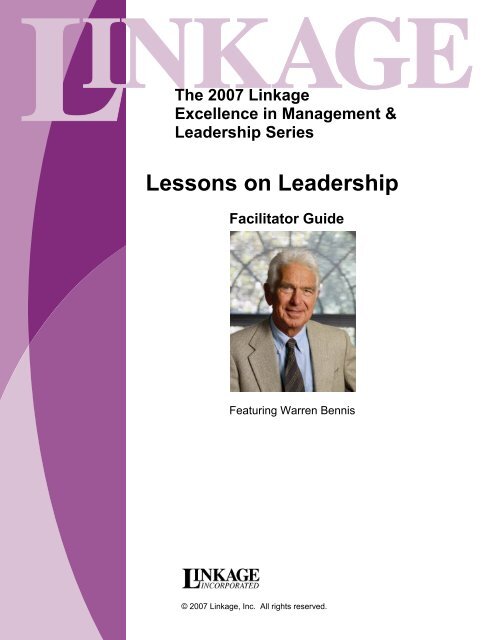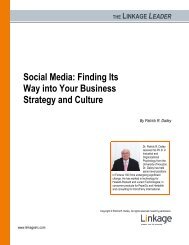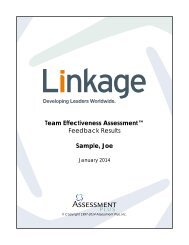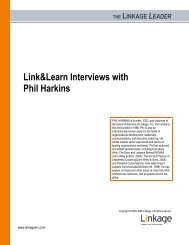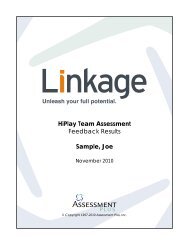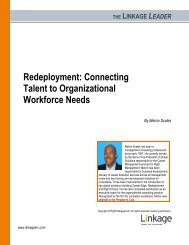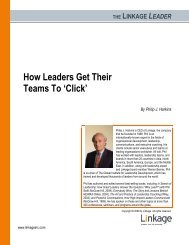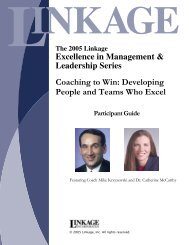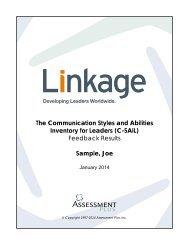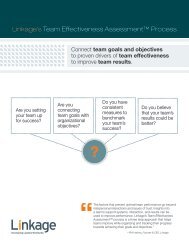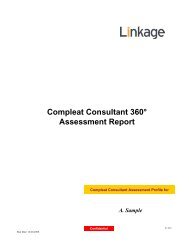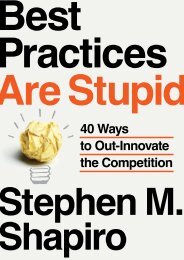Lessons on Leadership - Linkage, Inc.
Lessons on Leadership - Linkage, Inc.
Lessons on Leadership - Linkage, Inc.
Create successful ePaper yourself
Turn your PDF publications into a flip-book with our unique Google optimized e-Paper software.
The 2007 <strong>Linkage</strong><br />
Excellence in Management &<br />
<strong>Leadership</strong> Series<br />
<str<strong>on</strong>g>Less<strong>on</strong>s</str<strong>on</strong>g> <strong>on</strong> <strong>Leadership</strong><br />
Facilitator Guide<br />
Featuring Warren Bennis<br />
© 2007 <strong>Linkage</strong>, <strong>Inc</strong>. All rights reserved.
<str<strong>on</strong>g>Less<strong>on</strong>s</str<strong>on</strong>g> <strong>on</strong> <strong>Leadership</strong><br />
Facilitator Guide<br />
Table of C<strong>on</strong>tents<br />
INTRODUCTION AND MATERIALS REQUIRED..............................................2<br />
Introducti<strong>on</strong> ......................................................................................................2<br />
Materials: Pre-Broadcast Presentati<strong>on</strong> ............................................................3<br />
Partial List of Books Written by Warren Bennis ...............................................3<br />
PRE-BROADCAST SESSION ...........................................................................4<br />
BROADCAST .....................................................................................................9<br />
POST-BROADCAST SESSION .......................................................................12<br />
FACILITATION OVERVIEW.............................................................................14<br />
The Seven Principles of Facilitati<strong>on</strong>...............................................................14<br />
BEFORE: PRE-BROADCAST PLANNING .....................................................17<br />
DURING: FACILITATION SKILLS, BEHAVIORS, AND TECHNIQUE............21<br />
Keys to Promoting Learning: The Seven Principles of Facilitati<strong>on</strong>.................21<br />
Creating a Comfortable Learning Envir<strong>on</strong>ment..............................................21<br />
The Ragged Start...........................................................................................22<br />
Developing and Managing Participati<strong>on</strong> ........................................................22<br />
Dealing with Challenging Behavior ................................................................22<br />
Debriefing Basics ...........................................................................................23<br />
Giving Clear, C<strong>on</strong>cise Instructi<strong>on</strong>s.................................................................23<br />
Running Skill Practices ..................................................................................25<br />
Evaluati<strong>on</strong> Methods .......................................................................................26<br />
AFTER: TAKING IT HOME ..............................................................................27<br />
Post-Broadcast Program Opti<strong>on</strong>s ..................................................................27<br />
ADDITIONAL RESOURCES ............................................................................29<br />
About <strong>Linkage</strong> ................................................................................................29<br />
<strong>Linkage</strong>’s <strong>Leadership</strong> Programs.....................................................................30<br />
Best Practices Resources..............................................................................31<br />
The 2007 <strong>Linkage</strong> Excellence in Management & <strong>Leadership</strong> Series⎯<strong>Linkage</strong>, <strong>Inc</strong>. 1
<str<strong>on</strong>g>Less<strong>on</strong>s</str<strong>on</strong>g> <strong>on</strong> <strong>Leadership</strong><br />
Facilitator Guide<br />
Introducti<strong>on</strong> and Materials Required<br />
Introducti<strong>on</strong><br />
Welcome to the <strong>Linkage</strong> broadcast, <str<strong>on</strong>g>Less<strong>on</strong>s</str<strong>on</strong>g> <strong>on</strong> <strong>Leadership</strong>. This is the third of eight<br />
broadcasts in <strong>Linkage</strong>’s 2007 Excellence in Management & <strong>Leadership</strong> Series and features Dr.<br />
Warren Bennis, “Dean of leadership gurus” according to Forbes Magazine. Dr. Bennis is a<br />
best-selling author/editor of more than 2000 articles and 27 books <strong>on</strong> the subjects of leadership,<br />
change, and creative collaborati<strong>on</strong>.<br />
This guide was developed to help you make the most of the presentati<strong>on</strong> with your audience or<br />
group. In this guide you’ll find:<br />
• Background material to help add richness to your discussi<strong>on</strong>s.<br />
• Activities for a variety of group sizes and of varying leadership levels. Depending <strong>on</strong><br />
your unique audience (and your own facilitati<strong>on</strong> capabilities), you may wish to modify<br />
these activities to better meet the needs of your group(s).<br />
• Facilitati<strong>on</strong> tips and techniques that you may find useful as you prepare to facilitate the<br />
pre- and post-broadcast discussi<strong>on</strong>s.<br />
Use this guide and activities as they fit your needs. Before preparing for the broadcast, you will<br />
want to quickly preview this entire guide to determine how best to leverage the activities for<br />
your audience. Because this guide was designed for a variety of facilitati<strong>on</strong> scenarios, it will<br />
likely include activities that may not exactly fit yours.<br />
The 2007 <strong>Linkage</strong> Excellence in Management & <strong>Leadership</strong> Series⎯<strong>Linkage</strong>, <strong>Inc</strong>. 2
<str<strong>on</strong>g>Less<strong>on</strong>s</str<strong>on</strong>g> <strong>on</strong> <strong>Leadership</strong><br />
Facilitator Guide<br />
Materials: Pre and post Broadcast Sessi<strong>on</strong>s<br />
The following materials are important for the pre and post-broadcast sessi<strong>on</strong>s:<br />
• Agenda<br />
• Flip chart markers<br />
• Tape<br />
• Easel and chart paper<br />
• Participant materials (<strong>on</strong>e set per participant)<br />
• Name cards (opti<strong>on</strong>al depending <strong>on</strong> your setting)<br />
• Questi<strong>on</strong> sheets to capture the questi<strong>on</strong>s that participants will want to ask Dr. Bennis<br />
during the final 30 minutes of the broadcast.<br />
• Pencils or pens<br />
Partial list of Publicati<strong>on</strong>s<br />
The following is a partial list of some of Dr. Bennis’ best known publicati<strong>on</strong>s:<br />
• Co-leaders: The Power of Great Partnerships, David A Heenan, Warren G Bennis.<br />
Wiley, 2000.<br />
• Geeks and Geezers: How Era, Values and Defining Moments Shape Leaders, Warren<br />
Bennis, Robert J Thomas. Harvard Business School Press, 2002.<br />
• Human Side of Enterprise, Warren Bennis, Douglas McGregor. McGraw Hill<br />
Educati<strong>on</strong>, 1985.<br />
• Leaders: Strategies for Taking Charge, Warren Bennis, Burt Nanus. Harpercollins,<br />
2004.<br />
• Learning to Lead: A Workbook <strong>on</strong> Becoming a Leader, Warren Bennis, Joan<br />
Goldsmith. Perseus Publishing, 1997.<br />
• Managing the Dream, Warren G Bennis. Perseus Books, 2000.<br />
• On Becoming a Leader, Warren Bennis. Addis<strong>on</strong> Wesley, 1989.<br />
• Organizing Genius: The Secrets of Creative Collaborati<strong>on</strong>, Charles Handy, Warren<br />
Bennis, Patricia Biederman. Perseus Publishing, 1997.<br />
The 2007 <strong>Linkage</strong> Excellence in Management & <strong>Leadership</strong> Series⎯<strong>Linkage</strong>, <strong>Inc</strong>. 3
<str<strong>on</strong>g>Less<strong>on</strong>s</str<strong>on</strong>g> <strong>on</strong> <strong>Leadership</strong><br />
Facilitator Guide<br />
Pre-Broadcast Program<br />
Suggested: 50 minutes<br />
VISUALS/<br />
MATERIALS TOPIC/ACTIVITY TIME/NOTES<br />
Welcome and Introducti<strong>on</strong>s<br />
15-30 minutes<br />
OPEN the sessi<strong>on</strong>:<br />
5 minutes<br />
Page 1<br />
• “Welcome to this sessi<strong>on</strong>. This is the third of eight<br />
broadcasts that are part of the 2007 Excellence in<br />
Management & <strong>Leadership</strong> Series developed by <strong>Linkage</strong>.<br />
Today, we’ll be featuring best-selling author and world<br />
renowned leadership expert Dr. Warren Bennis.”<br />
• “Dr. Bennis has been instrumental in shaping leadership<br />
thinking and research through the decades.”<br />
• The segments both leading up to, and after the sessi<strong>on</strong>,<br />
are designed to help you take a deeper dive into the<br />
c<strong>on</strong>cepts and tools developed by Dr. Bennis.<br />
Page 5<br />
REFER to the Partial List of Publicati<strong>on</strong>s by Warren Bennis<br />
INTRODUCE yourself.<br />
REVIEW Basic Premise for the sessi<strong>on</strong>.<br />
REVIEW Sessi<strong>on</strong> Agenda<br />
5 minutes<br />
5 minutes<br />
If needed<br />
CONDUCT participant introducti<strong>on</strong>s<br />
15 minutes<br />
The 2007 <strong>Linkage</strong> Excellence in Management & <strong>Leadership</strong> Series⎯<strong>Linkage</strong>, <strong>Inc</strong>. 4
<str<strong>on</strong>g>Less<strong>on</strong>s</str<strong>on</strong>g> <strong>on</strong> <strong>Leadership</strong><br />
Facilitator Guide<br />
VISUALS/<br />
MATERIALS TOPIC/ACTIVITY TIME/NOTES<br />
<str<strong>on</strong>g>Less<strong>on</strong>s</str<strong>on</strong>g> <strong>on</strong> <strong>Leadership</strong>: Exercise 1<br />
25 minutes<br />
Page 7<br />
EXPLAIN: We all have certain shared beliefs about leadership,<br />
including what leaders do and d<strong>on</strong>’t do. However, given our<br />
individual experiences, we undoubtedly also have different<br />
definiti<strong>on</strong>s and points of view of what it means to lead. Let’s test<br />
that idea…<br />
CONDUCT exercise (individual): Your <strong>Leadership</strong> Definiti<strong>on</strong><br />
5 minutes<br />
Here’s how to run the exercise…<br />
ASK every<strong>on</strong>e in the group to write down their answers to<br />
the questi<strong>on</strong>s <strong>on</strong> page 7.<br />
CONDUCT Debrief by soliciting 3-4 examples<br />
5 minutes<br />
Psst…here’s a hint!<br />
Try to gather opini<strong>on</strong>s that differ from <strong>on</strong>e another. Also,<br />
have fun with the last questi<strong>on</strong>!<br />
TRANSITION: Our leadership point of view is shaped by our life<br />
experiences. Whether c<strong>on</strong>scious or unc<strong>on</strong>scious, our<br />
experiences shape and influence how we define and approach<br />
our roles as leaders. Let’s take a closer look at those experiences<br />
that Dr. Bennis calls Crucibles.<br />
Supplemental Frameworks and C<strong>on</strong>cepts: Crucibles<br />
EXPLAIN:<br />
15 minutes<br />
Page 17<br />
• Crucibles are intense, transformati<strong>on</strong>al experiences from<br />
which a leader changes dramatically. They are places<br />
where essential questi<strong>on</strong>s are asked: who am I Who<br />
could I be Who should I be How should I relate to<br />
others<br />
• They are places where <strong>on</strong>e extracts a different sense of<br />
meaning leading to a new definiti<strong>on</strong> of self<br />
• They are often grueling tests<br />
REFER to an example<br />
Psst…here’s a hint!<br />
You may want to share a pers<strong>on</strong>al example of a<br />
crucible. Alternatively, chose an example that<br />
participants can relate to (e.g. defining moments that<br />
the company has endured, transformative social<br />
movements, or events such as September 11th).<br />
The 2007 <strong>Linkage</strong> Excellence in Management & <strong>Leadership</strong> Series⎯<strong>Linkage</strong>, <strong>Inc</strong>. 5
<str<strong>on</strong>g>Less<strong>on</strong>s</str<strong>on</strong>g> <strong>on</strong> <strong>Leadership</strong><br />
Facilitator Guide<br />
VISUALS/<br />
MATERIALS TOPIC/ACTIVITY TIME/NOTES<br />
ASK: “What are some of the crucibles that we as a company have<br />
experienced”<br />
SAY: “Let’s explore our own points of view and where they come<br />
from by identifying the crucibles that have shaped them.”<br />
Your <strong>Leadership</strong> Story: Exercise 2<br />
70 minutes<br />
CONDUCT Exercise (Individual): Your <strong>Leadership</strong> Story<br />
20 minutes<br />
Page 8-12<br />
How to run the exercise…<br />
1. Ask participants to turn to page 8 of the manual<br />
2. Have them read the instructi<strong>on</strong>s and begin the<br />
exercise<br />
CONDUCT exercise (small groups): Your <strong>Leadership</strong> Story<br />
Report-out<br />
50 minutes<br />
How to run the exercise…<br />
1. Request that participants find 3 others to work with<br />
(forms group of 4);<br />
2. Instruct participants to share as much or as little<br />
about their reflecti<strong>on</strong> as they feel they can;<br />
3. Ask each pers<strong>on</strong> to take turns speaking about their<br />
crucibles;<br />
4. Request that people refrain from giving each other<br />
feedback (this is just about rec<strong>on</strong>necting with<br />
memories and events that have a great deal of<br />
meaning)<br />
TRANSITION: We’ve had a chance to begin exploring how<br />
crucibles impact our approach to leadership. Now, we’ll hear from<br />
Dr. Bennis. After the broadcast, we’ll come back as a group to<br />
reflect <strong>on</strong> your experience with this exercise.<br />
The 2007 <strong>Linkage</strong> Excellence in Management & <strong>Leadership</strong> Series⎯<strong>Linkage</strong>, <strong>Inc</strong>. 6
<str<strong>on</strong>g>Less<strong>on</strong>s</str<strong>on</strong>g> <strong>on</strong> <strong>Leadership</strong><br />
Facilitator Guide<br />
Broadcast<br />
95 minutes<br />
VISUALS/<br />
MATERIALS TOPIC/ACTIVITY TIME/NOTES<br />
BROADCAST SESSION<br />
Introducti<strong>on</strong> to Broadcast<br />
95 MINUTES<br />
5 minutes<br />
Page 28<br />
EXPLAIN: Dr. Bennis will be speaking for 45 minutes and then<br />
answering questi<strong>on</strong>s for the remaining 45 minutes of his<br />
broadcast.<br />
ASK participants to hand-in questi<strong>on</strong>s to you (the facilitator) for<br />
possible c<strong>on</strong>siderati<strong>on</strong> by Dr. Bennis.<br />
Psst…here’s a hint!<br />
Make sure people understand that Dr. Bennis may not<br />
resp<strong>on</strong>d to their particular questi<strong>on</strong> due to the number<br />
of people participating in the broadcast.<br />
COLLECT questi<strong>on</strong>s and communicate to <strong>Linkage</strong><br />
Fax 1.877.892.0170 (from within U.S.)<br />
Fax 646.349.3661 (from outside U.S.)<br />
Email: leadership2007@linkage-inc.com<br />
Broadcast Presentati<strong>on</strong><br />
90 minutes<br />
The 2007 <strong>Linkage</strong> Excellence in Management & <strong>Leadership</strong> Series⎯<strong>Linkage</strong>, <strong>Inc</strong>. 7
<str<strong>on</strong>g>Less<strong>on</strong>s</str<strong>on</strong>g> <strong>on</strong> <strong>Leadership</strong><br />
Facilitator Guide<br />
Post-Broadcast Program<br />
Suggested: 2-3 hours<br />
VISUALS/<br />
MATERIALS TOPIC/ACTIVITY TIME/NOTES<br />
<str<strong>on</strong>g>Less<strong>on</strong>s</str<strong>on</strong>g> <strong>on</strong> <strong>Leadership</strong> (c<strong>on</strong>tinued)<br />
30 minutes<br />
WELCOME participants back from the broadcast.<br />
ASK: “What stood out for you from the broadcast<br />
SAY: “As you heard, <strong>on</strong>e of Dr. Bennis’ core beliefs is in the<br />
power of crucibles. You had a chance to reflect <strong>on</strong> those before<br />
the broadcast. Let’s talk about that experience.”<br />
CONDUCT debrief of <strong>Leadership</strong> Stories (focus <strong>on</strong> less<strong>on</strong>s<br />
learned)<br />
20 minutes<br />
Psst…here’s a hint!<br />
C<strong>on</strong>sider these questi<strong>on</strong>s to spark c<strong>on</strong>versati<strong>on</strong>:<br />
−<br />
−<br />
How does life experience impact your leadership<br />
approach<br />
What leadership less<strong>on</strong>s did your crucibles teach<br />
you<br />
Page 19<br />
Page 19<br />
TRANSITION: Crucibles have the potential to build and to<br />
destroy; to shape and to devastate. What makes the difference is<br />
a leader’s ability to adapt. We’ll be taking a close look at that skill,<br />
but first let’s take a moment to get the blood going!<br />
Supplemental Framework and C<strong>on</strong>cepts:<br />
Adaptive Capability<br />
EXPLAIN: Research suggests that exemplary leaders use their<br />
crucibles to grow and develop by using four key skills or<br />
competencies referred to as the Big Four:<br />
REFER to page 19.<br />
SAY: “Let’s take a closer look at what we know to be the key skill,<br />
adaptive capability.”<br />
DEFINE Adaptive Capability<br />
SAY:<br />
• “Adaptive capability is an almost magical ability to<br />
transcend adversity, with all its attendant stresses, and to<br />
emerge str<strong>on</strong>ger than before.”<br />
• “It is <strong>on</strong>e of the attributes that sustain and define leaders<br />
in every era, of any age or culture.”<br />
5 minutes<br />
5 minutes<br />
The 2007 <strong>Linkage</strong> Excellence in Management & <strong>Leadership</strong> Series⎯<strong>Linkage</strong>, <strong>Inc</strong>. 8
<str<strong>on</strong>g>Less<strong>on</strong>s</str<strong>on</strong>g> <strong>on</strong> <strong>Leadership</strong><br />
Facilitator Guide<br />
VISUALS/<br />
MATERIALS TOPIC/ACTIVITY TIME/NOTES<br />
REFER to an example<br />
Psst…here’s a hint!<br />
You may want to share a pers<strong>on</strong>al example of adaptive<br />
capability. Alternatively, chose an example that<br />
participants can relate to (e.g. a leader adapting to new<br />
demands and challenges, or an organizati<strong>on</strong> able to<br />
fundamentally shift its directi<strong>on</strong> and focus as a way to<br />
resp<strong>on</strong>d)<br />
Adaptive Moments: Exercise 3<br />
60-80 minutes<br />
CONDUCT exercise (Trios): Adaptive Moments<br />
15 minutes<br />
Page 15<br />
Here’s how to run the exercise…<br />
−<br />
−<br />
−<br />
Ask participants to think about a time when they<br />
dem<strong>on</strong>strated adaptive capability, and a time when<br />
they didn’t<br />
Ask participants to find two partners<br />
In their groups, have participants discuss the<br />
questi<strong>on</strong>s <strong>on</strong> page 15 of the participant handout<br />
REFER to the following questi<strong>on</strong>s:<br />
• What is the value of adaptive capability in your role as a<br />
leader<br />
• What triggers your willingness and ability to adapt<br />
• What triggers your willingness and ability to remain<br />
steadfast / unchanging<br />
• How could you help create a culture of adaptive leaders<br />
CONDUCT debrief<br />
10 minutes<br />
Psst…here’s a hint!<br />
Use the questi<strong>on</strong>s to guide your debrief<br />
Supplemental Framework and C<strong>on</strong>cepts: Listening<br />
EXPLAIN: Listening can be an adaptive strategy—a way to<br />
practice adaptive capability.<br />
10 minutes<br />
PRESENT the following Shakespearean quotati<strong>on</strong>:<br />
“When Cicero spoke, men listened. When Caesar spoke,<br />
men marched”<br />
ASK: “What strikes you about this quote”<br />
The 2007 <strong>Linkage</strong> Excellence in Management & <strong>Leadership</strong> Series⎯<strong>Linkage</strong>, <strong>Inc</strong>. 9
<str<strong>on</strong>g>Less<strong>on</strong>s</str<strong>on</strong>g> <strong>on</strong> <strong>Leadership</strong><br />
Facilitator Guide<br />
VISUALS/<br />
MATERIALS TOPIC/ACTIVITY TIME/NOTES<br />
SAY: “Listening can be an adaptive strategy <strong>on</strong>ly if it reflects<br />
genuine curiosity, reflecti<strong>on</strong>, and flexibility.”<br />
ASK: “What tends to be your biggest challenge to remaining<br />
curious, thoughtful, and flexible<br />
DEFINE Ladder of Inference<br />
Page 20-21<br />
Important points to make…<br />
1. How we interpret the world has to do with the filters<br />
through which we see it;<br />
2. Our filters are influenced by a number of variables<br />
including era, values, geography, culture, and others;<br />
5 minutes<br />
3. Our beliefs help us “see”—c<strong>on</strong>sequently we can “see”<br />
some things, and others we cannot;<br />
4. Our beliefs are c<strong>on</strong>stantly being reinforced by what<br />
we “see”<br />
Pages 22<br />
Pages 25-26<br />
TRANSITION: Let’s take a brief look at how era might impact your<br />
pers<strong>on</strong>al ladder.<br />
REFER to The Impact of The Times<br />
DEFINE Key Strategies for Listening (70-30-10)<br />
CONDUCT Dem<strong>on</strong>strati<strong>on</strong> (Opti<strong>on</strong>al)<br />
How to run this exercise…<br />
1. Place two chairs in fr<strong>on</strong>t of the room, <strong>on</strong>e for you (the<br />
trainer) and <strong>on</strong>e for a participant-volunteer;<br />
Psst…here’s a hint!<br />
During the break, find a participant to be a volunteer<br />
for this demo.<br />
5 minutes<br />
5 minutes<br />
15-20 minutes<br />
2. Have the volunteer come to the fr<strong>on</strong>t of the room and<br />
sit facing each other (with the rest of the participants<br />
looking <strong>on</strong>);<br />
3. Begin the exercise by having the volunteer talk to you<br />
about an issue, a problem, or an opportunity that they<br />
have (make sure that it’s real, not hypothetical);<br />
4. Be sure to model the listening techniques presented;<br />
The 2007 <strong>Linkage</strong> Excellence in Management & <strong>Leadership</strong> Series⎯<strong>Linkage</strong>, <strong>Inc</strong>. 10
<str<strong>on</strong>g>Less<strong>on</strong>s</str<strong>on</strong>g> <strong>on</strong> <strong>Leadership</strong><br />
Facilitator Guide<br />
VISUALS/<br />
MATERIALS TOPIC/ACTIVITY TIME/NOTES<br />
5. Stop the c<strong>on</strong>versati<strong>on</strong> every 2-3 minutes to point out<br />
specific techniques or to ask the group for their<br />
observati<strong>on</strong>s.<br />
CONDUCT a brief debrief of the demo by asking:<br />
10 minutes<br />
• What did you notice<br />
• What struck you about what I did or didn’t do<br />
• What was the impact <strong>on</strong> the speaker<br />
Listening as an Ally: Exercise 4<br />
40-50 minutes<br />
CONDUCT exercise (pairs): Listening As An Ally<br />
30-40 minutes<br />
Page 16<br />
Here’s how to run the exercise…<br />
1. Ask participants to find a partner;<br />
2. Have every<strong>on</strong>e in the room reflect <strong>on</strong> an issue and<br />
their positi<strong>on</strong> <strong>on</strong> that issue-- something that has<br />
meaning for them;<br />
−<br />
For example, with the issue of promoti<strong>on</strong>s, <strong>on</strong>e<br />
might have the positi<strong>on</strong> that “people have to earn<br />
their stripes.”<br />
3. Ask participants to decide who will speak and who will<br />
listen for the first round (there are two rounds to this<br />
exercise);<br />
4. LISTENERS—The listener begins with a statement<br />
that summarizes their positi<strong>on</strong>;<br />
5. SPEAKERS— The speaker must then assume an<br />
opposing positi<strong>on</strong> even if does not reflect his or her<br />
true belief;<br />
Psst…here’s a hint!<br />
Instruct speakers to do everything possible to<br />
represent the positi<strong>on</strong> as authentically and as<br />
accurately as possible.<br />
6. The listener must use the Listening Skills presented<br />
to test ideas and assumpti<strong>on</strong>s and remain in inquiry,<br />
even when speaking to some<strong>on</strong>e with a dramatically<br />
different perspective;<br />
7. After 10 minutes, instruct speakers to give listeners<br />
feedback;<br />
The 2007 <strong>Linkage</strong> Excellence in Management & <strong>Leadership</strong> Series⎯<strong>Linkage</strong>, <strong>Inc</strong>. 11
<str<strong>on</strong>g>Less<strong>on</strong>s</str<strong>on</strong>g> <strong>on</strong> <strong>Leadership</strong><br />
Facilitator Guide<br />
VISUALS/<br />
MATERIALS TOPIC/ACTIVITY TIME/NOTES<br />
8. After 3-4 minutes of feedback, switch roles and begin<br />
again.<br />
CONDUCT debrief<br />
EXPLAIN<br />
10 minutes<br />
• Internal c<strong>on</strong>versati<strong>on</strong>s fueled by beliefs like “I’m right and<br />
you’re wr<strong>on</strong>g; you’re naive and uninformed; you’re young<br />
and inexperienced; I d<strong>on</strong>’t have time for this”-- get in the<br />
way of developing adaptive capability;<br />
• How we listen and what we listen for is directly linked to<br />
the beliefs and assumpti<strong>on</strong>s we hold;<br />
• Those beliefs come from experiences that have shaped<br />
who we are as leaders—our crucibles;<br />
• Because our beliefs and assumpti<strong>on</strong>s often go unchecked<br />
and untested, they can have very powerful effects <strong>on</strong> our<br />
ability to adapt and to lead.<br />
TRANSITION: Let’s spend a few minutes before we end our day,<br />
thinking about what we might do more of, less of, or differently in<br />
the weeks to come to strengthen our leadership ability.<br />
Taking it Home (Acti<strong>on</strong> Planning)<br />
10 minutes<br />
CONDUCT exercise (pairs): Taking It Home<br />
Here’s how to run the exercise…<br />
1. Ask participants to find their coaching partner;<br />
2. Have participants discuss:<br />
−<br />
−<br />
One key learning—<strong>on</strong>e thing they take from the<br />
day;<br />
One key acti<strong>on</strong>—<strong>on</strong>e thing they plan to do less of,<br />
more of, or differently<br />
ASK for volunteers to share examples.<br />
Program C<strong>on</strong>clusi<strong>on</strong><br />
5 minutes<br />
Thank participants for investing this time in their own leadership<br />
development.<br />
The 2007 <strong>Linkage</strong> Excellence in Management & <strong>Leadership</strong> Series⎯<strong>Linkage</strong>, <strong>Inc</strong>. 12
<str<strong>on</strong>g>Less<strong>on</strong>s</str<strong>on</strong>g> <strong>on</strong> <strong>Leadership</strong><br />
Facilitator Guide<br />
Facilitati<strong>on</strong> Overview<br />
The following pages explain <strong>Linkage</strong>’s beliefs about the fundamental principles of facilitati<strong>on</strong>,<br />
and include brief reminders, tips, and techniques for before, during, and after the program<br />
facilitati<strong>on</strong>.<br />
The Seven Principles of Facilitati<strong>on</strong><br />
1. Be Courageous<br />
The first priority for a facilitator is to let go of the need to be in complete c<strong>on</strong>trol<br />
and acknowledge and accept that facilitati<strong>on</strong> is about taking risks. Allowing<br />
yourself to go out of your comfort z<strong>on</strong>e is critical to becoming a good facilitator.<br />
The following is a list of some of the challenges you may (and should) face as you<br />
facilitate:<br />
−<br />
−<br />
−<br />
−<br />
−<br />
Try new activities and topics.<br />
Invite challenge and disagreement from your audience, in both<br />
the c<strong>on</strong>tent and facilitati<strong>on</strong>.<br />
Embrace the complexity of your subject; acknowledge that you<br />
do not have all of the answers.<br />
Acknowledge and face the challenges of a diverse audience<br />
(opini<strong>on</strong>s, backgrounds, attitudes).<br />
Challenge your audience in order to enhance their learning. Push<br />
individuals bey<strong>on</strong>d their comfort z<strong>on</strong>es by asking compelling and<br />
thought-provoking questi<strong>on</strong>s.<br />
2. Be a Role Model<br />
As a facilitator you have a dual role: learner and leader. As a learner, you model<br />
participati<strong>on</strong> and openness to learning. If you are open to enhancing your own<br />
learning experience by respecting participants’ knowledge and c<strong>on</strong>tributi<strong>on</strong>s, the<br />
audience will follow in kind. Your own energy, curiosity, interest in and enjoyment<br />
of the subject and in the participants should provide a str<strong>on</strong>g example.<br />
The sec<strong>on</strong>d type of model is the leader – the facilitator who “walks the talk.” For<br />
example, if you are facilitating a communicati<strong>on</strong>s skills course, exemplify<br />
outstanding communicati<strong>on</strong> skills, particularly the specific skills that are the<br />
cornerst<strong>on</strong>es of the program (e.g., use open-ended questi<strong>on</strong>s if you are presenting a<br />
module about their importance). Being a role model of this kind will earn you<br />
respect and credibility.<br />
The 2007 <strong>Linkage</strong> Excellence in Management & <strong>Leadership</strong> Series⎯<strong>Linkage</strong>, <strong>Inc</strong>. 13
<str<strong>on</strong>g>Less<strong>on</strong>s</str<strong>on</strong>g> <strong>on</strong> <strong>Leadership</strong><br />
Facilitator Guide<br />
3. Balance Flexibility and Resp<strong>on</strong>sibility<br />
A key skill of excepti<strong>on</strong>al facilitators is the ability to listen well, accurately read and<br />
interpret the needs of the participants, and make adjustments accordingly. Being<br />
both flexible and sp<strong>on</strong>taneous will benefit both you and the audience. At the same<br />
time, you must deliver <strong>on</strong> your promise to meet the stated learning objectives within<br />
the timeframes of the program, as well as manage both time and your own reacti<strong>on</strong>s<br />
to challenging participant behaviors.<br />
4. Make It Theirs<br />
Value what participants bring to the program. Adult learners need and deserve to be<br />
respected for their life experience and knowledge. As a facilitator, encouraging<br />
participati<strong>on</strong> and asking appropriately probing questi<strong>on</strong>s can open a wealth of<br />
resources for every<strong>on</strong>e in the room.<br />
<strong>Linkage</strong>’s distance learning programs and skill-building workshops are designed to<br />
maximize participants’ input and sharing through discussi<strong>on</strong> of workplace issues,<br />
paired and small group business simulati<strong>on</strong>s, case study analysis, skills practice,<br />
coaching and feedback, best practices sharing, and networking. Building <strong>on</strong><br />
participants’ experience is a key comp<strong>on</strong>ent to a successful learning process. The<br />
best facilitators are adept at drawing this out and referring to it at appropriate points<br />
in the program.<br />
5. Make It Yours<br />
Your effectiveness is heightened when you c<strong>on</strong>nect with the material and<br />
pers<strong>on</strong>alize it so that you are fully comfortable and authentic in fr<strong>on</strong>t of your group.<br />
This facilitator guide is not meant to be a script for you to memorize. Instead, our<br />
intent is to provide a guide to acquaint you with the program c<strong>on</strong>tent, objectives,<br />
and activities to promote learning. When you are passi<strong>on</strong>ate about the c<strong>on</strong>tent, you<br />
naturally foster learning and passi<strong>on</strong> in others. The energy that you put into making<br />
the material yours by creating and using your own life experience and workplace<br />
examples will emanate to your audience and improve your facilitati<strong>on</strong> skills<br />
immensely.<br />
6. Focus <strong>on</strong> Applicati<strong>on</strong><br />
When all is said and d<strong>on</strong>e, the participants need to take what they have learned and<br />
make it practical and useable in their daily work. Your role as a facilitator is to<br />
ensure that the c<strong>on</strong>tent is understood and assimilated in a way that makes it<br />
compelling and relevant to the participants – engaging them to apply, practice, and<br />
experiment with new skills to improve/enhance their own and their organizati<strong>on</strong>’s<br />
performance. <strong>Linkage</strong>’s programs are designed with a substantial amount of skillbuilding<br />
practice and applicati<strong>on</strong>. These should never be shortchanged.<br />
Throughout the program, it is critical for the facilitator to stress the applicability of<br />
all new c<strong>on</strong>tent and learning.<br />
The 2007 <strong>Linkage</strong> Excellence in Management & <strong>Leadership</strong> Series⎯<strong>Linkage</strong>, <strong>Inc</strong>. 14
<str<strong>on</strong>g>Less<strong>on</strong>s</str<strong>on</strong>g> <strong>on</strong> <strong>Leadership</strong><br />
Facilitator Guide<br />
7. Link It to the Business<br />
This broadcast program does not occur in a vacuum. For all facilitators, it is critical<br />
that you have a solid understanding of how the training that you are providing<br />
c<strong>on</strong>nects with the business goals, performance objectives, and organizati<strong>on</strong>al<br />
challenges that your audience faces. We str<strong>on</strong>gly recommend that you c<strong>on</strong>tact each<br />
participant prior to the program to better understand specific issues and motivati<strong>on</strong>s<br />
for participating in the program, as well as roles and levels of experience.<br />
For internal trainers, the more you know about your organizati<strong>on</strong>’s business<br />
envir<strong>on</strong>ment, strategy, systems, and culture, the more effective and credible you will<br />
be. Additi<strong>on</strong>ally, you should know how this single program aligns with the overall<br />
framework of any management or leadership training initiatives.<br />
The 2007 <strong>Linkage</strong> Excellence in Management & <strong>Leadership</strong> Series⎯<strong>Linkage</strong>, <strong>Inc</strong>. 15
<str<strong>on</strong>g>Less<strong>on</strong>s</str<strong>on</strong>g> <strong>on</strong> <strong>Leadership</strong><br />
Facilitator Guide<br />
Before: Pre-Broadcast Planning<br />
Preparing Yourself<br />
Know Your Presenter<br />
Warren Bennis Ph.D. is University Professor and Distinguished Professor of Business<br />
Administrati<strong>on</strong> at the University of Southern California and the founding chairman of USC’s<br />
<strong>Leadership</strong> Institute. Bennis was successor to Douglas McGregor as chairman of the<br />
organizati<strong>on</strong> studies department at M.I.T. He also taught at Harvard and Bost<strong>on</strong> Universities.<br />
Later, he was Provost and Executive Vice President of the State University of New York-<br />
Buffalo and President of the University of Cincinnati.<br />
Dr. Bennis has published over 2000 articles and written 27 books including: On Becoming a<br />
Leader (which was translated into 19 languages), Why Leaders Can’t Lead, and The Unreality<br />
Industry, co-authored with Ian Mitroff. Two of his books have earned the coveted McKinsey<br />
Award for the Best Book <strong>on</strong> Management He has served in an advisory capacity to the past<br />
four U.S. presidents and c<strong>on</strong>sulted to many corporati<strong>on</strong>s and agencies and to the United<br />
Nati<strong>on</strong>s.<br />
Awarded 11 h<strong>on</strong>orary degrees, Bennis has also received numerous awards including the<br />
Distinguished Service Award of the American Board of Professi<strong>on</strong>al Psychologists and the<br />
Perry L. Rohrer C<strong>on</strong>sulting Practice Award of the American Psychological Associati<strong>on</strong>.<br />
Know Your Topic – <strong>Leadership</strong><br />
Warren Bennis writes about the importance of leadership and the value it brings an<br />
organizati<strong>on</strong>:<br />
According to a study by Andersen C<strong>on</strong>sulting’s Institute for Strategic Change: the<br />
stock price of companies perceived as being well led grew 900 percent over a 10-<br />
year period, compared to just 74 percent growth in companies perceived to lack<br />
good leadership. And Fortune, in its 1998 round up of America’s most admired<br />
companies, identifies the comm<strong>on</strong> denominator of exemplary organizati<strong>on</strong>s. “The<br />
truth is that no <strong>on</strong>e factor makes a company admirable,” wrote Thomas Stewart,<br />
“but if you were forced to pick the <strong>on</strong>e that makes the most difference, you’d pick<br />
leadership.”<br />
Much has been written about leadership and a simple search in your library or <strong>on</strong> the Internet<br />
reveals a wealth of material <strong>on</strong> the subject. You may wish to focus your review using the<br />
following links:<br />
http://www.pfdf.org/leaderbooks/l2l/spring99/bennis.html<br />
http://www.bpubs.com/Management_Science/<strong>Leadership</strong>/<br />
http://www.inc.com/guides/leadership_strat/20642.html<br />
The 2007 <strong>Linkage</strong> Excellence in Management & <strong>Leadership</strong> Series⎯<strong>Linkage</strong>, <strong>Inc</strong>. 16
<str<strong>on</strong>g>Less<strong>on</strong>s</str<strong>on</strong>g> <strong>on</strong> <strong>Leadership</strong><br />
Facilitator Guide<br />
Know the C<strong>on</strong>text<br />
C<strong>on</strong>sider how this material fits into participants’ individual goals as managers and/or leaders,<br />
how it c<strong>on</strong>nects to the organizati<strong>on</strong>’s goals and challenges, and how it might reinforce any<br />
internal management or leadership development programs or initiatives.<br />
Determine how the informati<strong>on</strong> supports, complements, or reinforces any professi<strong>on</strong>al<br />
development seminars or management/leadership development programs or initiatives already<br />
existing within the organizati<strong>on</strong>.<br />
Practice Preparati<strong>on</strong><br />
Read the Participant Materials to gain a thorough understanding of what will be presented in<br />
the broadcast.<br />
Read the Facilitator’s Guide:<br />
• Identify key points.<br />
• Familiarize yourself with all of the activities. Select the <strong>on</strong>es you will use.<br />
• Prepare any needed flip charts.<br />
• Identify any required audio-visual and/or technological tools.<br />
• Practice your delivery.<br />
• C<strong>on</strong>tact <strong>Linkage</strong>, <strong>Inc</strong>. with any additi<strong>on</strong>al questi<strong>on</strong>s.<br />
Co-facilitati<strong>on</strong> Guidelines<br />
Co-facilitati<strong>on</strong> is opti<strong>on</strong>al, especially for a group of more than 25 people. Communicating and<br />
preparing with your co-facilitator before the program will help to create a cohesive and<br />
dynamic partnership. C<strong>on</strong>sider exchanging some of the following informati<strong>on</strong> in a preprogram<br />
teleph<strong>on</strong>e or in-pers<strong>on</strong> meeting:<br />
• Levels of familiarity, expertise, and comfort with the topic/c<strong>on</strong>tent.<br />
• Mutual understanding of your roles before, during, and after the program.<br />
• The strengths you believe you bring to facilitating the program.<br />
• The areas in which you feel you will need support.<br />
• Your typical training/facilitati<strong>on</strong> style.<br />
• Specific objectives you have regarding the program or pre/post-program activities.<br />
The 2007 <strong>Linkage</strong> Excellence in Management & <strong>Leadership</strong> Series⎯<strong>Linkage</strong>, <strong>Inc</strong>. 17
<str<strong>on</strong>g>Less<strong>on</strong>s</str<strong>on</strong>g> <strong>on</strong> <strong>Leadership</strong><br />
Facilitator Guide<br />
Preparing the Participants<br />
Depending <strong>on</strong> how this broadcast will be used within your organizati<strong>on</strong>, you may want to<br />
c<strong>on</strong>sider some or all of the following ideas.<br />
C<strong>on</strong>tacting Participants<br />
Call program participants before the program to introduce yourself and learn about their<br />
specific expectati<strong>on</strong>s and areas of interest with regard to the program c<strong>on</strong>tent.<br />
Offer assistance to the participants in completing the pre-broadcast activities. (See below.)<br />
Pre-Work Opti<strong>on</strong>s<br />
Provide program participants with their Participant Materials at least two weeks prior to the<br />
broadcast.<br />
• Point out the pre-broadcast activities that each participant is expected to complete prior<br />
to the broadcast.<br />
• Stress the importance of completing these pre-broadcast activities for maximum<br />
participant learning from this professi<strong>on</strong>al development opportunity.<br />
• Send participants related articles or business cases.<br />
C<strong>on</strong>tact Participants’ Managers (Opti<strong>on</strong>al)<br />
As appropriate, discuss the program with each participant’s manager. Take this opportunity to<br />
fully involve the participants’ managers in this professi<strong>on</strong>al development process and stress the<br />
importance of their support in <strong>on</strong>-going learning. Suggest that managers discuss this<br />
professi<strong>on</strong>al development opportunity with their employees both before and after the broadcast.<br />
The purpose of this discussi<strong>on</strong> is to provide support for the learning and give program<br />
participants an opportunity to apply their learning in a positive atmosphere.<br />
Preparing the Learning Envir<strong>on</strong>ment<br />
Flip Chart Basics<br />
Creating:<br />
• Title each chart.<br />
• Use the 6x6 rule: No more than 6 words per line and no more than 6 lines.<br />
• Keep letters 1”- 2” high.<br />
The 2007 <strong>Linkage</strong> Excellence in Management & <strong>Leadership</strong> Series⎯<strong>Linkage</strong>, <strong>Inc</strong>. 18
<str<strong>on</strong>g>Less<strong>on</strong>s</str<strong>on</strong>g> <strong>on</strong> <strong>Leadership</strong><br />
Facilitator Guide<br />
• Print.<br />
• Use 2-3 colors per flip chart and change the color <strong>on</strong> each point to make the lines more<br />
distinguishable.<br />
• Create all flip charts ahead of time (except the interactive <strong>on</strong>es).<br />
• Use tape tabs to help you find a chart easily.<br />
Using:<br />
Posting:<br />
• Stand close, but d<strong>on</strong>’t “hug” the chart.<br />
• Talk to the audience, not to the chart.<br />
• Use abbreviated symbols, like arrows, circles, and underlining, for ease of<br />
communicati<strong>on</strong> and for emphasis.<br />
• Pre-tear tape and place <strong>on</strong> back of flip chart stand.<br />
• Post <strong>on</strong>ly the charts you need to refer to later.<br />
Classroom Enhancers (if applicable)<br />
• Props<br />
• Posters (Models, Parking Lot, Best Practices)<br />
• Program Road Map (Create a graphic representati<strong>on</strong> of the program c<strong>on</strong>tent and<br />
sequence.)<br />
• Music (When appropriate, music can boost the energy in the learning envir<strong>on</strong>ment, or it<br />
can be an enhancement during reflective writing activities. It can also be used during<br />
breaks to change the flow.)<br />
• Relevant quotes<br />
• Good food<br />
• Kinesthetic objects (Small colorful items <strong>on</strong> each table can help learners to c<strong>on</strong>centrate<br />
and stay focused.)<br />
The 2007 <strong>Linkage</strong> Excellence in Management & <strong>Leadership</strong> Series⎯<strong>Linkage</strong>, <strong>Inc</strong>. 19
<str<strong>on</strong>g>Less<strong>on</strong>s</str<strong>on</strong>g> <strong>on</strong> <strong>Leadership</strong><br />
Facilitator Guide<br />
During: Facilitati<strong>on</strong> Skills, Behaviors, and Techniques<br />
Keys to Promoting Learning: The Seven Principles of Facilitati<strong>on</strong><br />
1. Be courageous.<br />
2. Be a role model.<br />
3. Balance flexibility and resp<strong>on</strong>sibility.<br />
4. Make it theirs.<br />
5. Make it yours.<br />
6. Focus <strong>on</strong> applicati<strong>on</strong>.<br />
7. Link it to the business.<br />
Creating a Comfortable Learning Envir<strong>on</strong>ment<br />
C<strong>on</strong>trol distractors such as room temperature and lighting, pen tapping, sidebar discussi<strong>on</strong>s.<br />
Set and maintain ground rules. Ask participants for any ground rules they would like to see<br />
established and set your own. Here are some suggested ground rules to c<strong>on</strong>sider:<br />
• Be committed to learning – your own and every<strong>on</strong>e else’s.<br />
• Be a critical thinker. Be rigorous with others in your speaking, listening and thinking.<br />
D<strong>on</strong>’t allow your need to be “nice” to get in the way of learning and effectiveness.<br />
• Be an active participant. Share your thoughts, observati<strong>on</strong>s, questi<strong>on</strong>s, and feelings<br />
about the c<strong>on</strong>tent and the program itself in order to forward the acti<strong>on</strong> and learning.<br />
The more you give, the more you’ll get. Turn your complaints into suggesti<strong>on</strong>s to<br />
enhance the learning envir<strong>on</strong>ment – do not hold <strong>on</strong>to them.<br />
• Listen actively and, to the best of your ability, without passing judgment. Be open to<br />
moments of c<strong>on</strong>fusi<strong>on</strong>, discrepancy, diss<strong>on</strong>ance, disbelief, and disagreement as<br />
opportunities for substantial learning for every<strong>on</strong>e.<br />
• Respect and uphold c<strong>on</strong>fidentiality. Names, situati<strong>on</strong>s, and perspectives or opini<strong>on</strong> of<br />
the organizati<strong>on</strong> and its leadership may surface during the course. This informati<strong>on</strong><br />
must remain in the room.<br />
The 2007 <strong>Linkage</strong> Excellence in Management & <strong>Leadership</strong> Series⎯<strong>Linkage</strong>, <strong>Inc</strong>. 20
<str<strong>on</strong>g>Less<strong>on</strong>s</str<strong>on</strong>g> <strong>on</strong> <strong>Leadership</strong><br />
Facilitator Guide<br />
The Ragged Start<br />
Some participants come early, while others may arrive late. Having an activity for people to<br />
focus <strong>on</strong> at their own pace is a way to begin the learning process while waiting for others.<br />
Below is a list of generic opti<strong>on</strong>s for Ragged Start activities.<br />
• Have a list of questi<strong>on</strong>s or quotati<strong>on</strong>s, related to the course topic, <strong>on</strong> a flip chart for<br />
participants to reflect <strong>on</strong> or post their resp<strong>on</strong>ses.<br />
• Have the participants informally introduce themselves to other participants as people<br />
enter the room.<br />
• Hand out a recent article related to the program topic.<br />
Developing and Managing Participati<strong>on</strong><br />
Facilitators need to be aware of who is talking too much and who is not talking enough⎯and<br />
this includes self-m<strong>on</strong>itoring. Effective facilitators balance lecture and giving informati<strong>on</strong> with<br />
dialogue by drawing out the participants’ experiences, insights, and thoughts. Limit your own<br />
talking time to a maximum of 40%.<br />
To encourage participati<strong>on</strong> you can do the following:<br />
• Ask open-ended questi<strong>on</strong>s that cannot be answered with a “yes” or “no” answer.<br />
(“What…” “How…” “Tell me about…” “Explain…”)<br />
• Count to 10 after you have asked a questi<strong>on</strong>.<br />
• D<strong>on</strong>’t ask too many questi<strong>on</strong>s in a row. Ask just <strong>on</strong>e and wait. If there is no resp<strong>on</strong>se,<br />
rephrase the questi<strong>on</strong> slightly or sp<strong>on</strong>taneously ask table teams to discuss it briefly then<br />
report out.<br />
• Use polling. Ask for a show of hands.<br />
• Give verbal and n<strong>on</strong>verbal reinforcement to reward participati<strong>on</strong>. (“I’m glad you<br />
brought that up. Thank you.” Nod, smile, write their resp<strong>on</strong>ses <strong>on</strong> the flip chart.)<br />
• Defer to the group whenever possible when asked a questi<strong>on</strong>. (“What do others think<br />
about …”)<br />
• Invite a participant to replace you in recording discussi<strong>on</strong> comments or key points <strong>on</strong><br />
the flip chart.<br />
• Ask close-ended questi<strong>on</strong>s when necessary to limit participati<strong>on</strong> or re-establish focus.<br />
• Paraphrase lengthy comments in a c<strong>on</strong>cise way and link them back to course c<strong>on</strong>tent.<br />
The 2007 <strong>Linkage</strong> Excellence in Management & <strong>Leadership</strong> Series⎯<strong>Linkage</strong>, <strong>Inc</strong>. 21
<str<strong>on</strong>g>Less<strong>on</strong>s</str<strong>on</strong>g> <strong>on</strong> <strong>Leadership</strong><br />
Facilitator Guide<br />
• Ask other participants for their thoughts to balance participati<strong>on</strong> or move the focus<br />
away from any<strong>on</strong>e who is beginning to dominate the discussi<strong>on</strong>.<br />
• Encourage use of a “Parking Lot.” Provide Post-it notes for participants and post a<br />
“Parking Lot” flipchart somewhere in the room, for thoughts, questi<strong>on</strong>s, and comments<br />
that are not directly relevant to the discussi<strong>on</strong> at hand. Review this at the end of the<br />
program to generate ideas or resources.<br />
Dealing with Challenging Behavior<br />
Debriefing Basics<br />
• Know your own “hot butt<strong>on</strong>s.” Be aware of your own points of vulnerability.<br />
• Stay calm. Use body language that communicates a state of alert and relaxed openness.<br />
• Check your understanding of other’s positi<strong>on</strong>s and perspectives and clarify your own<br />
perspective.<br />
• Acknowledge participants’ points of view and value their c<strong>on</strong>cerns.<br />
• Ask the group to give their feedback.<br />
• Ask to discuss the issue in private or call a break if the “challenge” is not relevant to the<br />
group.<br />
• Help people turn their complaints into acti<strong>on</strong>. Ask, “What might you suggest to change<br />
that/make a difference”<br />
Effective debriefing improves the quality and quantity of discussi<strong>on</strong> and learning for both the<br />
participants and the facilitator. The purpose is to surface the discoveries and insights (the “aha”<br />
moments) of the participants. Debriefing focuses attenti<strong>on</strong> <strong>on</strong> the participant’s experience,<br />
their thoughts and feelings, key learning points, and acti<strong>on</strong> steps for<br />
implementati<strong>on</strong>/applicati<strong>on</strong>. It provides participants with the opportunity to actively analyze<br />
their experience, become more engaged in their learning, and value their own unique<br />
perspective.<br />
For any pre or post-program activities, your role as a facilitator is to structure and ask a set of<br />
probing questi<strong>on</strong>s and to actively listen. This is the participant’s time to share their thoughts –<br />
not yours. C<strong>on</strong>sider yourself a guest, not an expert.<br />
The 2007 <strong>Linkage</strong> Excellence in Management & <strong>Leadership</strong> Series⎯<strong>Linkage</strong>, <strong>Inc</strong>. 22
<str<strong>on</strong>g>Less<strong>on</strong>s</str<strong>on</strong>g> <strong>on</strong> <strong>Leadership</strong><br />
Facilitator Guide<br />
Ask open-ended questi<strong>on</strong>s. Examples include:<br />
Comfort Level<br />
• What was easy/difficult<br />
• At what point did it get easier/more difficult Why<br />
• How comfortable were you doing _____<br />
• How did you feel doing ________<br />
• What was your biggest challenge<br />
Observati<strong>on</strong><br />
• What did you notice/see happening<br />
• What surprised you<br />
• What did you notice about _______<br />
C<strong>on</strong>cepts<br />
• What principle did you discover<br />
• What did you learn/relearn<br />
• What do you most want to remember<br />
• What ideas or c<strong>on</strong>cepts are new to you<br />
• What c<strong>on</strong>necti<strong>on</strong>s did you make<br />
Benefits/Applicability<br />
• What did you find most helpful<br />
• How was this useful<br />
• How would that be beneficial/applicable back <strong>on</strong> the job<br />
• How would that be beneficial to your employees/colleagues/ customers<br />
• What tasks might be easier if these skills/tools were used<br />
• How could this help you<br />
The 2007 <strong>Linkage</strong> Excellence in Management & <strong>Leadership</strong> Series⎯<strong>Linkage</strong>, <strong>Inc</strong>. 23
<str<strong>on</strong>g>Less<strong>on</strong>s</str<strong>on</strong>g> <strong>on</strong> <strong>Leadership</strong><br />
Facilitator Guide<br />
Giving Clear, C<strong>on</strong>cise Instructi<strong>on</strong>s<br />
• Use simple sentences.<br />
• Give step-by-step directi<strong>on</strong>s <strong>on</strong> the flip chart or <strong>on</strong> an overhead.<br />
• Indicate the length of time participants will have to complete the activity.<br />
• Speak clearly and audibly.<br />
• Model or illustrate when appropriate.<br />
• Check for understanding. Ask, “Who has the first questi<strong>on</strong>”<br />
• Review/Preview.<br />
• Review key points at the end of each secti<strong>on</strong>.<br />
• Let participants know what is next.<br />
Running Skill Practices<br />
Give very clear verbal instructi<strong>on</strong>s and use prepared written instructi<strong>on</strong>s (<strong>on</strong> a slide, flip chart,<br />
or a page in the participant guide).<br />
Emphasize the value of practicing c<strong>on</strong>cepts versus talking about c<strong>on</strong>cepts theoretically.<br />
When you listen, d<strong>on</strong>’t be obtrusive or distracting. Sit or stand to the side and try not to make<br />
eye c<strong>on</strong>tact. The participants will be tempted to ask you if they’re “doing it right.” Discourage<br />
this temptati<strong>on</strong> through your own body language.<br />
Intervene <strong>on</strong>ly when you think that mistakes are being repeated or if the participant practicing<br />
the skill is truly stuck. Whisper a suggesti<strong>on</strong> so as not to interrupt the flow of the discussi<strong>on</strong> or<br />
dialogue within the skill building practice.<br />
Look for what the learners are doing well and point it out after the activity is complete. Take<br />
notes if necessary in order to remember at least <strong>on</strong>e point from each participant/skill user.<br />
Evaluati<strong>on</strong> Methods<br />
Opti<strong>on</strong>s:<br />
Ask participants to share their thoughts <strong>on</strong> the day’s material and workshop. Flipchart a list of<br />
+/Δ. The Delta symbol (Δ) represents change.<br />
Ask participants to write an an<strong>on</strong>ymous resp<strong>on</strong>se to the following <strong>on</strong> a loose piece of paper or<br />
Post-It Note:<br />
The 2007 <strong>Linkage</strong> Excellence in Management & <strong>Leadership</strong> Series⎯<strong>Linkage</strong>, <strong>Inc</strong>. 24
<str<strong>on</strong>g>Less<strong>on</strong>s</str<strong>on</strong>g> <strong>on</strong> <strong>Leadership</strong><br />
Facilitator Guide<br />
• What <strong>on</strong>e moment today stands out most str<strong>on</strong>gly for you<br />
• What is <strong>on</strong>e issue or c<strong>on</strong>cern you still have that you would like to see addressed<br />
• What is <strong>on</strong>e specific thing that would improve your learning experience before, during,<br />
or after the broadcast program<br />
The 2007 <strong>Linkage</strong> Excellence in Management & <strong>Leadership</strong> Series⎯<strong>Linkage</strong>, <strong>Inc</strong>. 25
<str<strong>on</strong>g>Less<strong>on</strong>s</str<strong>on</strong>g> <strong>on</strong> <strong>Leadership</strong><br />
Facilitator Guide<br />
After: Taking It Home<br />
Post-Broadcast Program Opti<strong>on</strong>s<br />
1. Build into the program’s evaluati<strong>on</strong>s a specific questi<strong>on</strong> asking participants to<br />
record <strong>on</strong>e pers<strong>on</strong>al commitment they are making as a result of the program.<br />
C<strong>on</strong>sider sending pers<strong>on</strong>alized follow up emails to participants <strong>on</strong>e m<strong>on</strong>th after the<br />
course. The email c<strong>on</strong>tains:<br />
−<br />
−<br />
a thank you<br />
a reminder of their pers<strong>on</strong>al commitment<br />
− an invitati<strong>on</strong> to provide advice and coaching via the ph<strong>on</strong>e for up<br />
to 30 minutes<br />
The following is a sample letter:<br />
Dear NAME OF PARTICIPANT,<br />
Greetings!<br />
This is FACILITATOR NAME, the facilitator for the <strong>Linkage</strong><br />
Excellence in <strong>Leadership</strong> & Management Series you attended <strong>on</strong><br />
DATE. I hope you have found ways to apply the skills and tools you<br />
gained from the program to your daily work.<br />
I also want to remind you of the pers<strong>on</strong>al commitment you wrote <strong>on</strong><br />
your program evaluati<strong>on</strong> form. You wrote (EXAMPLE): “I’m going to<br />
recognize and reward at least three employees this week for the<br />
short-term wins that I identified in the course.” If you are willing to<br />
share, I’d be interested to hear how you are doing in relati<strong>on</strong> to that<br />
commitment, and to the general c<strong>on</strong>tent from the program.<br />
Finally, I welcome a ph<strong>on</strong>e call if you would like my coaching <strong>on</strong> any<br />
work issues related to our course work together. You can email me<br />
or call me at _______ to set up a call of up to 30 minutes.<br />
Best wishes,<br />
FACILITATOR NAME<br />
2. C<strong>on</strong>tact the managers of each participant to reinforce and transfer the learning of the<br />
participants. (Note: This should be d<strong>on</strong>e <strong>on</strong>ly with the explicit knowledge of, and<br />
agreement by, the participants ahead of time.)<br />
3. C<strong>on</strong>duct a half-day learning sessi<strong>on</strong> six to twelve weeks after the program for<br />
participants to regroup, reflect <strong>on</strong>, and recommit to effective daily performance.<br />
The 2007 <strong>Linkage</strong> Excellence in Management & <strong>Leadership</strong> Series⎯<strong>Linkage</strong>, <strong>Inc</strong>. 26
<str<strong>on</strong>g>Less<strong>on</strong>s</str<strong>on</strong>g> <strong>on</strong> <strong>Leadership</strong><br />
Facilitator Guide<br />
4. Over a period of m<strong>on</strong>ths, participants could receive additi<strong>on</strong>al resources to<br />
strengthen their skills, including:<br />
−<br />
−<br />
−<br />
Selected products (tools, job aids, articles)<br />
Targeted communicati<strong>on</strong>s (e-mail best practice tips, development<br />
suggesti<strong>on</strong>s, and research)<br />
Evaluati<strong>on</strong> of the effectiveness of the Excellence in <strong>Leadership</strong> &<br />
Management Series program<br />
The 2007 <strong>Linkage</strong> Excellence in Management & <strong>Leadership</strong> Series⎯<strong>Linkage</strong>, <strong>Inc</strong>. 27
<str<strong>on</strong>g>Less<strong>on</strong>s</str<strong>on</strong>g> <strong>on</strong> <strong>Leadership</strong><br />
Facilitator Guide<br />
Additi<strong>on</strong>al Resources<br />
About <strong>Linkage</strong><br />
<strong>Linkage</strong>, <strong>Inc</strong>. is a global organizati<strong>on</strong>al development company that specializes in leadership<br />
development. Serving the public and private sectors, the Company provides clients around the<br />
globe with integrated soluti<strong>on</strong>s that include strategic c<strong>on</strong>sulting services, customized <strong>on</strong>-site<br />
training experiences, tailored assessment services, and benchmark research.<br />
With a relentless commitment to learning, <strong>Linkage</strong> also offers a full range of c<strong>on</strong>ferences,<br />
institutes, summits, public workshops, and distance learning programs <strong>on</strong> leading-edge topics<br />
in leadership, management, HR, and OD. More than 100,000 leaders and managers have<br />
attended such a <strong>Linkage</strong> program since the Company’s founding in 1988.<br />
<strong>Linkage</strong> is headquartered in Burlingt<strong>on</strong>, Massachusetts, with regi<strong>on</strong>al offices in Minneapolis,<br />
Atlanta, San Francisco, L<strong>on</strong>d<strong>on</strong>, and Brussels. On two occasi<strong>on</strong>s, <strong>Linkage</strong> has been named to<br />
the <strong>Inc</strong>. 500, a list of the fastest-growing private companies in the United States.<br />
We can be reached by calling 781-402-5555 or through our website at:<br />
http://www.linkageinc.com/<br />
Skill Building Public and On-Site Workshops, Certificate Programs, and Certificati<strong>on</strong> and<br />
Licensing<br />
<strong>Linkage</strong> offers practical skill-building learning and development programs in the areas of<br />
management and leadership development, organizati<strong>on</strong>al development, human resources, and<br />
training and development. Our programs are based <strong>on</strong> cutting-edge research and deliver<br />
practical tools and methods for today’s organizati<strong>on</strong>al leaders.<br />
Public Workshops: A variety of our public workshops are scheduled across the United States<br />
and Europe. A current listing of workshops, locati<strong>on</strong>s, and dates is available <strong>on</strong> our website.<br />
On-Site Training: By combining the proven effectiveness of <strong>Linkage</strong>’s workshops with the<br />
c<strong>on</strong>venience, customizati<strong>on</strong>, and travel cost-savings of holding workshops at your site, you can<br />
create the ideal learning experience for your leaders, managers, employees, and colleagues.<br />
Certificate Programs: Certificate Programs are <strong>Linkage</strong>’s most comprehensive, focused, and<br />
diverse development programs. <strong>Linkage</strong> currently offers certificates in Organizati<strong>on</strong>al<br />
Development, Change <strong>Leadership</strong>, <strong>Leadership</strong> Development, HR C<strong>on</strong>sulting Skills,<br />
Transformati<strong>on</strong>al Selling, and Coaching Leaders.<br />
Certificati<strong>on</strong> and Licensing: <strong>Linkage</strong> certifies individuals to deliver our management and<br />
leadership learning programs, and then licenses the programs <strong>on</strong> an individual basis to certified<br />
individuals and their organizati<strong>on</strong>s.<br />
The 2007 <strong>Linkage</strong> Excellence in Management & <strong>Leadership</strong> Series⎯<strong>Linkage</strong>, <strong>Inc</strong>. 28
<str<strong>on</strong>g>Less<strong>on</strong>s</str<strong>on</strong>g> <strong>on</strong> <strong>Leadership</strong><br />
Facilitator Guide<br />
<strong>Linkage</strong>’s <strong>Leadership</strong> Programs<br />
<strong>Linkage</strong>’s approach to leadership is based <strong>on</strong> our belief that leaders need to be both learners<br />
and teachers. Leaders who learn are open to new possibilities and changes. Leaders who teach<br />
realize that communicating, coaching, and helping others is part of “what it takes.”<br />
Best Practices Resources<br />
To order any of these titles, c<strong>on</strong>tact <strong>Linkage</strong> Customer Service at 781.402.5555 or visit us <strong>on</strong><br />
the Web at: http://www.linkageinc.com/products/<br />
The <strong>Linkage</strong> Toolkit for Developing Leaders<br />
Foreword by Jay C<strong>on</strong>ger<br />
Authors: <strong>Linkage</strong> Senior and Principal C<strong>on</strong>sultants and Outside Thought Leaders<br />
This toolkit is designed to provide managers and leaders at all levels of your organizati<strong>on</strong> with<br />
the right tools to become successful and effective. It provides practical advice, ideas,<br />
behaviors, assessments, skill-building activities, and methods for leading yourself and others in<br />
your daily work. It is an excellent resource to create comm<strong>on</strong> leadership practices and<br />
language across organizati<strong>on</strong>al boundaries within your company.<br />
Best Practice Guidebooks⎯<strong>Linkage</strong>’s Best Practice Guidebooks for Teams, Process<br />
Improvement, and Tools<br />
These self-directed, self-paced, practical guidebooks provide best practice tools, processes, and<br />
models needed to be an effective manager or change leader, improve processes, and enable<br />
teams. All processes, models, and tools have been integrated and implemented with positive<br />
measurable change at such organizati<strong>on</strong>s as Raythe<strong>on</strong>, Mort<strong>on</strong>, Beatrice Foods, Ellerbe<br />
Beckett, GE Capital, Barclays Bank, and Volvo. The guidebooks have been effectively used by<br />
vice presidents, managers, supervisors, work team leaders, project managers, and other industry<br />
leaders across all major vertical industries.<br />
Best Practice Handbooks⎯Best Practices in Knowledge Management and Organizati<strong>on</strong>al<br />
Learning Handbook<br />
Foreword by Hubert Saint-Onge<br />
Authors: Phil Harkins, Louis Carter, and Amy Timmins, Editors<br />
Through in-depth “how-to” case studies, over 100 “take-away”exhibits, and research from the<br />
world’s foremost organizati<strong>on</strong>s, this best practice handbook provides practical, easy-to-apply<br />
training, models, tools, research and other essential elements for designing, delivering,<br />
evaluating and learning successful KM/OL programs. <strong>Inc</strong>luded in the handbook are: Microsoft,<br />
AT&T, Hewlett-Packard, Shell Oil Company, Ernst & Young, the World Bank, Buckman<br />
Labs, Norske Skog Flooring and more! The “how-to” case studies define KM/OL lexic<strong>on</strong>,<br />
The 2007 <strong>Linkage</strong> Excellence in Management & <strong>Leadership</strong> Series⎯<strong>Linkage</strong>, <strong>Inc</strong>. 29
<str<strong>on</strong>g>Less<strong>on</strong>s</str<strong>on</strong>g> <strong>on</strong> <strong>Leadership</strong><br />
Facilitator Guide<br />
evaluate return <strong>on</strong> investment, explain how to create a business case for KM/OL, and detail all<br />
stages of the KM/OL process.<br />
Best Practices in Organizati<strong>on</strong> and Human Resources Development Handbook<br />
Foreword by Richard Beckhard<br />
Authors: Louis Carter and David Giber, Editors<br />
<strong>Linkage</strong> selected 17 best practice organizati<strong>on</strong> and HR development initiatives in all major<br />
industries, for organizati<strong>on</strong>s such as Johns<strong>on</strong> & Johns<strong>on</strong>, Kraft Foods, Media One Group,<br />
Xerox, Boeing, Sun Microsystems, Nortel Networks, SmithKline Beecham, ServiceMaster,<br />
Allstate Insurance, Cellular One and Westinghouse. The book covers 5 of the hottest<br />
management topics today: organizati<strong>on</strong> development and change, leadership development,<br />
recruitment and retenti<strong>on</strong>, performance management, and coaching and mentoring. Using a<br />
case study approach, top practiti<strong>on</strong>ers detail the models, tools, training, processes and other<br />
critical elements that have made these initiatives so successful. The book also features<br />
c<strong>on</strong>tributi<strong>on</strong>s from such organizati<strong>on</strong> and human resources development experts as Richard<br />
Beckhard, Warner Burke, Jay C<strong>on</strong>ger, John Sullivan, Bev Kaye, and Ed Lawler. It is a rich<br />
resource for any manager, OD/HRD practiti<strong>on</strong>er, student, or facilitator of change. Use this<br />
handbook to apply learnings from any <strong>Linkage</strong> workshop.<br />
The Big Picture⎯A Systems Thinking Story for Managers<br />
Author: Carol Zulauf<br />
This is a story about Allan, a manager who starts off being very reactive and always “putting<br />
out the fires.” He gets rewarded for this type of behavior but in the process also alienates many<br />
of his direct reports and others in the organizati<strong>on</strong>. Slowly, he begins to learn more effective<br />
ways of interacting and incorporates the disciplines of systems thinking and organizati<strong>on</strong>al<br />
learning, to the huge benefit of himself, his colleagues, and his organizati<strong>on</strong>. Key Systems<br />
Thinking Principles, in additi<strong>on</strong> to Acti<strong>on</strong> Learning Steps for Leaders, are provided at the end<br />
of each chapter for you to implement <strong>on</strong> your way to becoming more of a ‘big picture’ systems<br />
thinker!<br />
The 2007 <strong>Linkage</strong> Excellence in Management & <strong>Leadership</strong> Series⎯<strong>Linkage</strong>, <strong>Inc</strong>. 30


